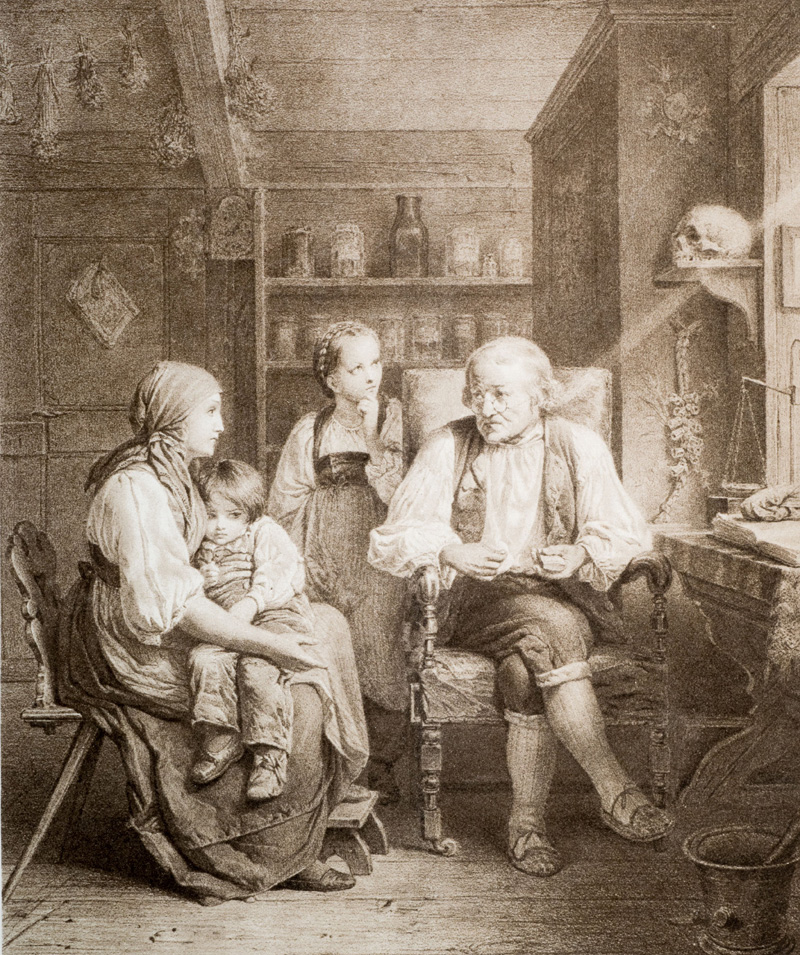Young Doctor
Siegfried Letzel
Hahnemann,
the young doctor
In this part of our series of articles, we begin to accompany Hahnemann in his medical practice.
At the age of twenty, Hahnemann finished his schooling in Meissen with a thesis written in Latin entitled “On the Wonderful Structure of the Human Hand.” He then began his medical studies in Leipzig. There, however, he was not taught any practical medicine, as there was no hospital attached to the university. All he could learn was basic theory. He therefore soon moved to Vienna to study bedside medicine under Dr. Quarin, personal physician to Empress Maria Theresa and Emperor Joseph II. Lack of money, however, meant that Hahnemann had to move to Baron von Brukenthal in Hermannstadt, Transylvania, where, from 1777 onwards, he organized his impressive library and coin collection – and at the same time worked as a family doctor. In 1779, Hahnemann came to Erlangen, where he completed his medical studies and earned his doctorate.
As early as 1784, the young doctor wrote his first major medical work, “Instructions for Thoroughly Healing Old Injuries and Putrid Ulcers . ” At that time, these ailments were usually only treated indirectly by physicians because of the nauseating wounds. They used bloodletting, cupping, sweating, and the application of lead ointments and plasters as their primary remedies. Hahnemann commented on this practice with the words: “The usual end of such treatments is brought about by old women, the executioner, the cattle doctor, the shepherd, and death. Cattle doctors are often more skilled at healing old wounds than even the most academically trained professor and member of any academies.”
Hahnemann was already developing his independent thinking and medical practice, while still employing traditional therapies. But he became increasingly unsure of his work, as the treatments of his and other colleagues rarely improved the patients’ suffering, but unfortunately often worsened it.
To make his therapies more successful, he employed various ‘adjusting screws’: “Movement is, next to food, the most essential need of the animal machine; it is through it that the clockwork is wound. Movement and healthy air alone drive every fluid of our body to its designated place, … intensifies the heartbeat, alone brings about proper, healthy digestion, and best of all invites rest, sleep, the time of refreshment and the creation of new vital spirits.” Hahnemann was a pioneer in the field of dietetics. More on this in a separate article.
Hahnemann also spoke in a robust, convincing way about the influence of lifestyle, professional activity, daily routine, and living conditions on health. Although this term didn’t even exist yet—Hahnemann was already a hygienist!
Back to ulcers: Hahnemann banned lead plasters and ointments from his practice. He dressed wounds using alcohol for disinfection and highly diluted sublimate water, sulfite, arsenic water, and Peruvian balsam. But he always used only ONE remedy at a time. He also took surgical steps, for example, by scraping the wound. Baldinger, a professor in Jena, Göttingen, and Marburg, wrote: “Hahnemann treated his subject very thoroughly and correctly. He shows how wrong the previous, mostly conventional treatment had been—and teaches a better one.” Hahnemann’s other writings were similarly positively reviewed.
Hahnemann made a name for himself early on among the medical profession. His approach to sexually transmitted diseases, typhus, scabies, and more was innovative.
Hahnemann had a reputation among his colleagues as a ” prudent, successful practitioner who achieved many excellent cures .” Hufeland described him as one of the most outstanding physicians in Germany. In 1791, the Leipzig Economic Society elected him as a member, followed by the Electoral Mainz Academy of Sciences and later the Physical-Medical Society in Erlangen.
However, Hahnemann increasingly came across as a troublemaker in the eyes of his medical colleagues. As early as 1784, he spoke disparagingly of the ‘fashionable doctors’. In 1786, in his book on arsenic, he railed against the miserable state of pharmacology at the time, against the “bungling physicians, the most fertile source of death, who, among other things, powdered arsenic in substance onto ulcers, thereby often causing the death of the sick, and who administered this remedy in easily fatal doses for intermittent fever . ” In 1790, he spoke out forcefully against the pharmacists of the time: “The old pharmacists, with their shallowness, vagueness, fairy tales, and untruths, have been imitated right up to the present day. We must forcefully tear ourselves away from these idolized authorities if we want to shake off the yoke of ignorance and superstition in one of the most important aspects of practical medicine. Now is the time.”
In order to discover the truth from the tangle of ‘observations’ and ‘experiences,’ he avoided the busy bedside manner practiced by his contemporaries, and he became quite hostile toward his medicinal colleagues. Hahnemann became an enthusiastic reformer of the medical system of his time. And thus began a completely new era in his scientific work…

